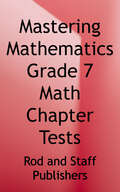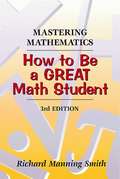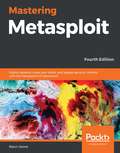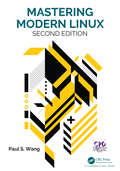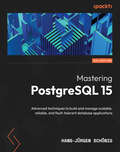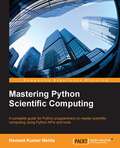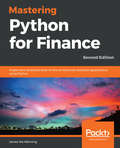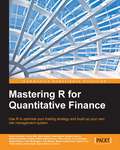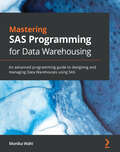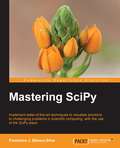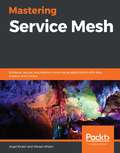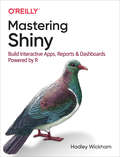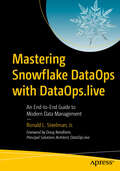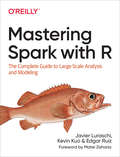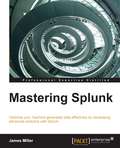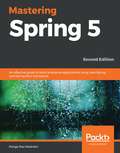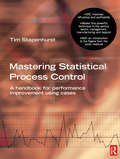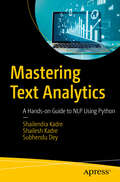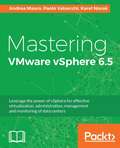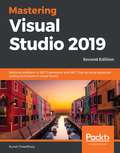- Table View
- List View
Mastering Mathematics: Grade 7 Chapter Tests (Mathematics for Christian Living Series)
by Rod and Staff PublishersChapter tests for Mastering Mathematics. Contains 13 chapter tests. Answers are found in the teacher's manuals.
Mastering Mathematics: How To Be A Great Math Student
by Richard Manning SmithProviding solid tips for every stage of study, Mastering Mathematics stresses the importance of a positive attitude and gives students the tools to succeed in their math course. This practical guide will help students: avoid mental blocks during math exams, identify and improve areas of weakness, get the most out of class time, study more effectively, overcome a perceived "low math ability," be successful on math tests, get back on track when feeling "lost," and much more!
Mastering Metasploit - Fourth Edition
by Nipun JaswalThis book targets professional penetration testers, security engineers, and law enforcement analysts who possess a basic knowledge of Metasploit, wish to master the Metasploit framework, and want to develop exploit and module development skills. Further, it helps all those researchers who want to add their custom functionalities to Metasploit. The book discusses Ruby programming and attack scripting using Cortana. A little knowledge and programming experience with Ruby and Cortana are required.
Mastering Modern Linux (Second Edition)
by Paul S. Wang<p>Mastering Modern Linux, Second Edition retains much of the good material from the previous edition, with extensive updates and new topics added. The book provides a comprehensive and up-to-date guide to Linux concepts, usage, and programming. The text helps the reader master Linux with a well-selected set of topics, and encourages hands-on practice. <p>The first part of the textbook covers interactive use of Linux via the Graphical User Interface (GUI) and the Command-Line Interface (CLI), including comprehensive treatment of the Gnome desktop and the Bash Shell. Using different apps, commands and filters, building pipelines, and matching patterns with regular expressions are major focuses. <p>Next comes Bash scripting, file system structure, organization, and usage. The following chapters present networking, the Internet and the Web, data encryption, basic system admin, as well as Web hosting. The Linux Apache MySQL/MariaDB PHP (LAMP) Web hosting combination is also presented in depth. <p>In the last part of the book, attention is turned to C-level programming. Topics covered include the C compiler, preprocessor, debugger, I/O, file manipulation, process control, inter-process communication, and networking. <p>The book includes many examples and complete programs ready to download and run. A summary and exercises of varying degrees of difficulty can be found at the end of each chapter. A companion website (http://mml.sofpower.com) provides appendices, information updates, an example code package, and other resources for instructors, as well as students.</p>
Mastering Numbers: Everyday Mathematics Made Simple
by Andrew JeffreyThe perfect antidote to numbers-phobia, this clear, concise guide explains everything you need to know about arithmetic, fractions, statistics, probability, algebra and geometry.We all use numbers every day, yet many people are uncomfortable with them, finding them daunting and difficult. Others treat numbers as a practical tool they can handle quite well, while failing to appreciate their most amazing qualities.This book is the antidote to number-phobia. As with learning to swim, youʼll never look back: these are skills youʼll use for the rest of your life. If you think youʼre good with numbers already, youʼll soon discover what youʼve been missing: the endless fascination and beauty of numbers, and – at the more practical level – a whole range of techniques and shortcuts you never knew existed.Mastering Numbers brings the subject to life, replacing the atmosphere of the classroom with the wonder of the magicianʼs workshop. In learning to enjoy numbers, we discover a multitude of practical skills – everything from understanding statistics and the odds gamblers face to the interest rates on savings and ways to maximise your returns. Never again need you flounder in a business meeting or an encounter with your bank manager – and if the chance arises to chat to him more casually, you could impress with stories about pi, prime numbers, Fermatʼs theorem, and much else besides.Full of enjoyable exercises, puzzles, demonstrations and self-testing interludes, this is a book to instruct and give pleasure.
Mastering PostgreSQL 15: Advanced techniques to build and manage scalable, reliable, and fault-tolerant database applications, 5th Edition
by Hans-Jurgen SchonigMaster the capabilities of PostgreSQL 15 to efficiently administer and maintain your database.Purchase of the print or Kindle book includes a free PDF eBook.Key FeaturesUsing real world examples, get to grips with expert PostgreSQL 15 conceptsExplore performance improvement, database replication, data replication, database administration, and moreExtend PostgreSQL's functionalities to suit your organization's needs with minimal effortBook DescriptionStarting with an introduction to the newly released features of PostgreSQL 15, this updated fifth edition will help you get to grips with PostgreSQL administration and how to build dynamic database solutions for enterprise apps, including designing both physical and technical aspects of the system.You'll explore advanced PostgreSQL features, such as logical replication, database clusters, advanced indexing, and user management to manage and maintain your database. You'll then work with the PostgreSQL optimizer, configure PostgreSQL for high speed, and move from Oracle to PostgreSQL. Among the other skills that the book will help you build, you'll cover transactions, handling recursions, working with JSON and JSONB data, and setting up a Patroni cluster. It will show you how to improve performance with query optimization. You'll also focus on managing network security and work with backups and replication while exploring useful PostgreSQL extensions that optimize the performance of large databases.By the end of this PostgreSQL book, you'll be able to use your database to its utmost capacity by implementing advanced administrative tasks with ease.What you will learnMake use of the indexing features in PostgreSQL and fine-tune the performance of your queriesWork with stored procedures and manage backup and recoveryGet the hang of replication and failover techniquesImprove the security of your database server and handle encryption effectivelyTroubleshoot your PostgreSQL instance for solutions to common and not-so-common problemsPerform database migration from Oracle to PostgreSQL with easeWho this book is forThis database administration book is for PostgreSQL developers, database administrators, and professionals who want to implement advanced functionalities and master complex administrative tasks with PostgreSQL 15. Prior experience in PostgreSQL and familiarity with the basics of database administration will assist with understanding key concepts covered in the book.
Mastering PowerShell Scripting: Automate and manage your environment using PowerShell 7.1, 4th Edition
by Chris DentGrasp advanced PowerShell 7.1 functionalities for effective automation of your environmentKey FeaturesSee PowerShell in action, from learning the fundamentals to creating classes, scripts, and modulesWork with dual code for PowerShell 7 and Windows PowerShellAutomate complex tasks, manipulate data, and secure your environmentBook DescriptionPowerShell scripts offer a convenient way to automate various tasks. This comprehensive guide starts with the basics before moving on to advanced topics to help you become a PowerShell 7.1 expert. This extensively revised edition includes two new chapters on debugging and troubleshooting and creating GUIs. Learn the new features of PowerShell 7.1 by working with parameters, objects, and .NET classes from within PowerShell 7.1. As you work through the chapters, you'll see how to efficiently manage substantial amounts of data and interact with other services using PowerShell 7.1. Make the most of PowerShell's automation features, using different methods to parse data, manipulate regular expressions, and work with Windows Management Instrumentation (WMI). Advanced topics include asynchronous processing, desired state configuration, using more complex scripts and filters, debugging issues, and error-handling techniques. By the end of this PowerShell book, you will be an expert in scripting with PowerShell 7.1.What you will learnOptimize code with functions, switches, and looping structuresWork with objects and operators to test and manipulate dataParse and manipulate different data typesCreate scripts and functions using PowerShellUse jobs, runspaces, and runspace pools to run code asynchronouslyWrite .NET classes with ease within PowerShellCreate and implement regular expressions in PowerShell scriptsMake use of advanced techniques to define and restrict the behavior of parametersWho this book is forThis book is aimed at beginners who want to understand the basics as well as experienced system administrators looking to extend their knowledge.Prior knowledge of PowerShell is beneficial but not essential to get the most value from this book. Some familiarity with operating systems would be useful, but not essential.
Mastering Python Scientific Computing
by Hemant Kumar MehtaA complete guide for Python programmers to master scientific computing using Python APIs and tools About This Book * The basics of scientific computing to advanced concepts involving parallel and large scale computation are all covered. * Most of the Python APIs and tools used in scientific computing are discussed in detail * The concepts are discussed with suitable example programs Who This Book Is For If you are a Python programmer and want to get your hands on scientific computing, this book is for you. The book expects you to have had exposure to various concepts of Python programming. What You Will Learn * Fundamentals and components of scientific computing * Scientific computing data management * Performing numerical computing using NumPy and SciPy * Concepts and programming for symbolic computing using SymPy * Using the plotting library matplotlib for data visualization * Data analysis and visualization using Pandas, matplotlib, and IPython * Performing parallel and high performance computing * Real-life case studies and best practices of scientific computing In Detail In today's world, along with theoretical and experimental work, scientific computing has become an important part of scientific disciplines. Numerical calculations, simulations and computer modeling in this day and age form the vast majority of both experimental and theoretical papers. In the scientific method, replication and reproducibility are two important contributing factors. A complete and concrete scientific result should be reproducible and replicable. Python is suitable for scientific computing. A large community of users, plenty of help and documentation, a large collection of scientific libraries and environments, great performance, and good support makes Python a great choice for scientific computing. At present Python is among the top choices for developing scientific workflow and the book targets existing Python developers to master this domain using Python. The main things to learn in the book are the concept of scientific workflow, managing scientific workflow data and performing computation on this data using Python. The book discusses NumPy, SciPy, SymPy, matplotlib, Pandas and IPython with several example programs. Style and approach This book follows a hands-on approach to explain the complex concepts related to scientific computing. It details various APIs using appropriate examples.
Mastering Python for Finance
by James Ma WeimingIf you are an undergraduate or graduate student, a beginner to algorithmic development and research, or a software developer in the financial industry who is interested in using Python for quantitative methods in finance, this is the book for you. It would be helpful to have a bit of familiarity with basic Python usage, but no prior experience is required.
Mastering Python for Finance: Implement advanced state-of-the-art financial statistical applications using Python, 2nd Edition
by James Ma WeimingTake your financial skills to the next level by mastering cutting-edge mathematical and statistical financial applicationsKey FeaturesExplore advanced financial models used by the industry and ways of solving them using PythonBuild state-of-the-art infrastructure for modeling, visualization, trading, and moreEmpower your financial applications by applying machine learning and deep learningBook DescriptionThe second edition of Mastering Python for Finance will guide you through carrying out complex financial calculations practiced in the industry of finance by using next-generation methodologies. You will master the Python ecosystem by leveraging publicly available tools to successfully perform research studies and modeling, and learn to manage risks with the help of advanced examples.You will start by setting up your Jupyter notebook to implement the tasks throughout the book. You will learn to make efficient and powerful data-driven financial decisions using popular libraries such as TensorFlow, Keras, Numpy, SciPy, and sklearn. You will also learn how to build financial applications by mastering concepts such as stocks, options, interest rates and their derivatives, and risk analytics using computational methods. With these foundations, you will learn to apply statistical analysis to time series data, and understand how time series data is useful for implementing an event-driven backtesting system and for working with high-frequency data in building an algorithmic trading platform. Finally, you will explore machine learning and deep learning techniques that are applied in finance.By the end of this book, you will be able to apply Python to different paradigms in the financial industry and perform efficient data analysis.What you will learnSolve linear and nonlinear models representing various financial problemsPerform principal component analysis on the DOW index and its componentsAnalyze, predict, and forecast stationary and non-stationary time series processesCreate an event-driven backtesting tool and measure your strategiesBuild a high-frequency algorithmic trading platform with PythonReplicate the CBOT VIX index with SPX options for studying VIX-based strategiesPerform regression-based and classification-based machine learning tasks for predictionUse TensorFlow and Keras in deep learning neural network architectureWho this book is forIf you are a financial or data analyst or a software developer in the financial industry who is interested in using advanced Python techniques for quantitative methods in finance, this is the book you need! You will also find this book useful if you want to extend the functionalities of your existing financial applications by using smart machine learning techniques. Prior experience in Python is required.
Mastering R for Quantitative Finance
by Edina Berlinger Ferenc IllésThis book is intended for those who want to learn how to use R's capabilities to build models in quantitative finance at a more advanced level. If you wish to perfectly take up the rhythm of the chapters, you need to be at an intermediate level in quantitative finance and you also need to have a reasonable knowledge of R.
Mastering R: A Beginner's Guide (Mastering Computer Science)
by Sufyan Bin UzayrR is a statistical computing and graphics programming language that you can use to clean, analyze, and graph data. It is widely used by researchers from various disciplines to estimate and display results and by teachers of statistics and research methods. This book is a detailed guide for beginners to understand R with an explanation of core statistical and research ideas. One of the powerful characteristics of R is that it is open-source, which means that anyone can access the underlying code used to run the program and add their own code for free. It will always be able to perform the latest statistical analyses as soon as anyone thinks of them. R corrects mistakes quickly and transparently and has put together a community of programming and statistical experts that you can turn to for help. Mastering R: A Beginner’s Guide not only explains how to program but also how to use R for visualization and modeling. The fundamental principles of R explained here are helpful to beginner and intermediate users interested in learning this highly technological and diverse language.
Mastering SAS Programming
by Monika WahiThis book is for managers leading data projects, and programmers or developers using SAS who want to effectively maintain a data lake, data mart, or data warehouse.
Mastering SAS Programming for Data Warehousing: An advanced programming guide to designing and managing Data Warehouses using SAS
by Monika WahiBuild a strong foundation in SAS data warehousing by understanding data transformation code and policy, data stewardship and management, interconnectivity between SAS and other warehousing products, and print and web reportingKey FeaturesUnderstand how to use SAS macros for standardizing extract, transform, and load (ETL) protocolsDevelop and use data curation files for effective warehouse managementLearn how to develop and manage ETL, policies, and print and web reports that meet user needsBook DescriptionSAS is used for various functions in the development and maintenance of data warehouses, thanks to its reputation of being able to handle ’big data’. This book will help you learn the pros and cons of storing data in SAS. As you progress, you’ll understand how to document and design extract-transform-load (ETL) protocols for SAS processes. Later, you’ll focus on how the use of SAS arrays and macros can help standardize ETL. The book will also help you examine approaches for serving up data using SAS and explore how connecting SAS to other systems can enhance the data warehouse user’s experience. By the end of this data management book, you will have a fundamental understanding of the roles SAS can play in a warehouse environment, and be able to choose wisely when designing your data warehousing processes involving SAS.What you will learnDevelop efficient ways to manage data input/output (I/O) in SASCreate and manage extract, transform, and load (ETL) code in SASStandardize ETL through macro variables, macros, and arraysIdentify data warehouse users and ensure their needs are metDesign crosswalk and other variables to serve analyst needsMaintain data curation files to improve communication and managementUse the output delivery system (ODS) for print and web reportingConnect other products to SAS to optimize storage and reportingWho this book is forThis book is for data architects, managers leading data projects, and programmers or developers using SAS who want to effectively maintain a data lake, data mart, or data warehouse.
Mastering SciPy
by Francisco J. Blanco-SilvaImplement state-of-the-art techniques to visualize solutions to challenging problems in scientific computing, with the use of the SciPy stackAbout This BookMaster the theory and algorithms behind numerical recipes and how they can be applied to real-world problemsLearn to combine the most appropriate built-in functions from the SciPy stack by understanding the connection between the sources of your problem, volume of data, or computer architectureA comprehensive coverage of all the mathematical techniques needed to solve the presented topics, with a discussion of the relevant algorithms built in the SciPy stackWho This Book Is ForIf you are a mathematician, engineer, or computer scientist with a proficiency in Python and familiarity with IPython, this is the book for you. Some basic knowledge of numerical methods in scientific computing would be helpful.What You Will LearnMaster relevant algorithms used in symbolic or numerical mathematics to address approximation, interpolation, differentiation, integration, root-finding, and optimization of scalar or multi-variate functionsDevelop different algorithms and strategies to efficiently store and manipulate large matrices of data, in particular to solve systems of linear equations, or compute their eigenvalues/eigenvectorsUnderstand how to model physical problems with systems of differential equations and distinguish the factors that dictate the strategies to solve themPerform statistical analysis, hypothesis test design and resolution, or data mining at a higher level, and apply them to real-life problems in the field of data analysisGain insights on the power of distances, Delaunay triangulations and Voronoi diagrams for Computational Geometry, and apply them to various engineering problemsFamiliarize yourself with different techniques in signal/image processing, including filtering audio, images, or video to extract information, features, or remove componentsIn DetailThe SciPy stack is a collection of open source libraries of the powerful scripting language Python, together with its interactive shells. This environment offers a cutting-edge platform for numerical computation, programming, visualization and publishing, and is used by some of the world's leading mathematicians, scientists, and engineers. It works on any operating system that supports Python and is very easy to install, and completely free of charge! It can effectively transform into a data-processing and system-prototyping environment, directly rivalling MATLAB and Octave.This book goes beyond a mere description of the different built-in functions coded in the libraries from the SciPy stack. It presents you with a solid mathematical and computational background to help you identify the right tools for each problem in scientific computing and visualization. You will gain an insight into the best practices with numerical methods depending on the amount or type of data, properties of the mathematical tools employed, or computer architecture, among other factors.The book kicks off with a concise exploration of the basics of numerical linear algebra and graph theory for the treatment of problems that handle large data sets or matrices. In the subsequent chapters, you will delve into the depths of algorithms in symbolic algebra and numerical analysis to address modeling/simulation of various real-world problems with functions (through interpolation, approximation, or creation of systems of differential equations), and extract their representing features (zeros, extrema, integration or differentiation).Lastly, you will move on to advanced concepts of data analysis, image/signal processing, and computational geometry.Style and approachPacked with real-world examples, this book explores the mathematical techniques needed to solve the presented topics, and focuses on the algorithms built in the SciPy stack.
Mastering Service Mesh: Enhance, secure, and observe cloud-native applications with Istio, Linkerd, and Consul
by Anjali Khatri Vikram Khatri Dinesh Nirmal Hamid Pirahesh Eric HernessUnderstand how to use service mesh architecture to efficiently manage and safeguard microservices-based applications with the help of examples Key Features Manage your cloud-native applications easily using service mesh architecture Learn about Istio, Linkerd, and Consul – the three primary open source service mesh providers Explore tips, techniques, and best practices for building secure, high-performance microservices Book Description Although microservices-based applications support DevOps and continuous delivery, they can also add to the complexity of testing and observability. The implementation of a service mesh architecture, however, allows you to secure, manage, and scale your microservices more efficiently. With the help of practical examples, this book demonstrates how to install, configure, and deploy an efficient service mesh for microservices in a Kubernetes environment. You'll get started with a hands-on introduction to the concepts of cloud-native application management and service mesh architecture, before learning how to build your own Kubernetes environment. While exploring later chapters, you'll get to grips with the three major service mesh providers: Istio, Linkerd, and Consul. You'll be able to identify their specific functionalities, from traffic management, security, and certificate authority through to sidecar injections and observability. By the end of this book, you will have developed the skills you need to effectively manage modern microservices-based applications. What you will learn Compare the functionalities of Istio, Linkerd, and Consul Become well-versed with service mesh control and data plane concepts Understand service mesh architecture with the help of hands-on examples Work through hands-on exercises in traffic management, security, policy, and observability Set up secure communication for microservices using a service mesh Explore service mesh features such as traffic management, service discovery, and resiliency Who this book is for This book is for solution architects and network administrators, as well as DevOps and site reliability engineers who are new to the cloud-native framework. You will also find this book useful if you're looking to build a career in DevOps, particularly in operations. Working knowledge of Kubernetes and building microservices that are cloud-native is necessary to get the most out of this book.
Mastering Shiny
by Hadley WickhamMaster the Shiny web framework—and take your R skills to a whole new level. By letting you move beyond static reports, Shiny helps you create fully interactive web apps for data analyses. Users will be able to jump between datasets, explore different subsets or facets of the data, run models with parameter values of their choosing, customize visualizations, and much more.Hadley Wickham from RStudio shows data scientists, data analysts, statisticians, and scientific researchers with no knowledge of HTML, CSS, or JavaScript how to create rich web apps from R. This in-depth guide provides a learning path that you can follow with confidence, as you go from a Shiny beginner to an expert developer who can write large, complex apps that are maintainable and performant.Get started: Discover how the major pieces of a Shiny app fit togetherPut Shiny in action: Explore Shiny functionality with a focus on code samples, example apps, and useful techniquesMaster reactivity: Go deep into the theory and practice of reactive programming and examine reactive graph componentsApply best practices: Examine useful techniques for making your Shiny apps work well in production
Mastering Snowflake DataOps with DataOps.live: An End-to-End Guide to Modern Data Management
by Ronald L. Steelman Jr.This practical, in-depth guide shows you how to build modern, sophisticated data processes using the Snowflake platform and DataOps.live—the only platform that enables seamless DataOps integration with Snowflake. Designed for data engineers, architects, and technical leaders, it bridges the gap between DataOps theory and real-world implementation, helping you take control of your data pipelines to deliver more efficient, automated solutions.. You&’ll explore the core principles of DataOps and how they differ from traditional DevOps, while gaining a solid foundation in the tools and technologies that power modern data management—including Git, DBT, and Snowflake. Through hands-on examples and detailed walkthroughs, you&’ll learn how to implement your own DataOps strategy within Snowflake and maximize the power of DataOps.live to scale and refine your DataOps processes. Whether you're just starting with DataOps or looking to refine and scale your existing strategies, this book—complete with practical code examples and starter projects—provides the knowledge and tools you need to streamline data operations, integrate DataOps into your Snowflake infrastructure, and stay ahead of the curve in the rapidly evolving world of data management. <span class
Mastering Spark with R: The Complete Guide to Large-Scale Analysis and Modeling
by Javier Luraschi Kevin Kuo Edgar RuizIf you’re like most R users, you have deep knowledge and love for statistics. But as your organization continues to collect huge amounts of data, adding tools such as Apache Spark makes a lot of sense. With this practical book, data scientists and professionals working with large-scale data applications will learn how to use Spark from R to tackle big data and big compute problems.Authors Javier Luraschi, Kevin Kuo, and Edgar Ruiz show you how to use R with Spark to solve different data analysis problems. This book covers relevant data science topics, cluster computing, and issues that should interest even the most advanced users.Analyze, explore, transform, and visualize data in Apache Spark with RCreate statistical models to extract information and predict outcomes; automate the process in production-ready workflowsPerform analysis and modeling across many machines using distributed computing techniquesUse large-scale data from multiple sources and different formats with ease from within SparkLearn about alternative modeling frameworks for graph processing, geospatial analysis, and genomics at scaleDive into advanced topics including custom transformations, real-time data processing, and creating custom Spark extensions
Mastering Splunk
by James MillerThis book is for those Splunk developers who want to learn advanced strategies to deal with big data from an enterprise architectural perspective. You need to have good working knowledge of Splunk.
Mastering Spring 5: An effective guide to build enterprise applications using Java Spring and Spring Boot framework, 2nd Edition
by Ranga Rao KaranamBuild scalable and flexible Rest APIs and microservices using the latest versions of Spring and Spring Boot Key Features Build Java-based enterprise applications using Spring 5.1 and Spring Boot 2.1 Create high performing, reusable, and scalable enterprise Java applications that are easy to test Gain powerful insights into advanced Spring and Spring Boot concepts to develop applications effectively Book Description Spring 5.1 is the latest release of the widely used Spring Framework. This book takes you through the evolution of building enterprise-ready applications with Spring and Spring Boot. Mastering Spring 5 starts with an overview of some of the important Spring Framework features relating to aspect-oriented programming, task scheduling, and scripting with the help of practical examples. You'll learn about the standard dependency injection specification for Java contexts and CDI and how the Spring Framework supports it. You'll gain an understanding of how application architectures have evolved from monoliths to microservices and be able to build your own microservices using Spring Boot. Complete with real-world examples, this book will help you gain powerful insights into Spring Boot 2.1 and learn how to develop cloud-native microservices with Spring Cloud. You'll even explore how to secure a REST API with Spring Security and get started with your first full stack application using React. Furthermore, you'll get to grips with Kotlin fundamentals and build a Kotlin project in Eclipse. By the end of this book, you'll be equipped with all the knowledge required to develop microservices and full stack applications with the Spring Framework. What you will learn Explore Spring Framework 5.1 features such as AOP, transaction management, task scheduling, and scripting Build REST APIs and microservices with Spring and Spring Boot Develop a secure REST API with Spring Security Build your first full stack React application Write efficient unit tests with Spring and Spring Boot Understand the advanced features that Spring Boot offers to develop and monitor applications Use Spring Cloud to deploy and manage applications on the Cloud Who this book is for This book is for experienced Java and enterprise Java developers and programmers who have a basic understanding of the Spring Framework.
Mastering Statistical Process Control
by Tim StapenhurstMastering Statistical Process Control shows how to understand business or process performance more clearly and more effectively. This practical book is based on a rich and varied selection of case studies from across industry and commerce, including material from the manufacturing, extractive and service sectors. It will enable readers to understand how SPC can be used to maximum effect, and will deliver more effective monitoring, control and improvement in systems, processes and management. The common obstacle to successful use of SPC is getting bogged down with control charts, forgetting that visual representation of data is but a tool and not an end in itself. Mastering SPC demonstrates how statistical tools are applied and used in reality. This is a book that will open up the power of SPC for many: managers, quality professionals, engineers and analysts, as well as students, will welcome the clarity and explanation that it brings to understanding the use and benefit of SPC in a wide range of engineering, production and service situations. Key case studies include using SPC to: · Measure quality and human factors · Monitor process performance accurately over long periods · Develop best-practice benchmarks using control charts · Maximise profitability of fixed assets · Improve customer service and satisfaction
Mastering Text Analytics: A Hands-on Guide to NLP Using Python
by Shailendra Kadre Shailesh Kadre Subhendu DeyThis book is a comprehensive guide to mastering Natural Language Processing (NLP), a rapidly growing field in AI-powered text and data analytics. It equips you with tools and techniques to extract valuable insights from both structured and unstructured data, enabling you to uncover insights beyond the reach of traditional data analysis methods and stay competitive in this evolving domain. The book starts with foundational concepts, such as collecting and extracting data for NLP projects, before progressing to advanced topics like applications of transfer learning in NLP and Large Language Models (LLMs). Each chapter emphasizes real-world applications and includes practical case studies to ensure the knowledge is immediately applicable. Throughout the book, readers will find Python code demonstrations, hands-on projects, and detailed explanations of key concepts. Special features include business use cases from industries like healthcare and customer service, practice exercises to reinforce learning, and explorations of emerging NLP technologies. These elements make the book not only informative but also highly engaging and interactive. By the end of the book, the reader will have a solid foundation in Generative AI techniques to apply them to complex challenges. Whether you&’re a budding data scientist or a seasoned professional, this guide will help you harness the power of AI-driven text and data analytics effectively. What you will learn: Understand NLP with easy-to-follow explanations, examples, and Python implementations. Explore techniques such as transformers, word embeddings, and pragmatic analysis in real-world contexts. Work with real-world datasets and apply pre-processing, tokenization, and text extraction using NLP libraries. How to build complete NLP pipelines from data collection to model implementation, including sentiment analysis and chatbots. Learn state-of-the-art methods like deep learning techniques in NLP, large language models (LLMs), and zero-shot learning in NLP. Who this book is for: This book is tailored for data scientists, machine learning engineers, AI practitioners, and software developers seeking to learn NLP techniques and apply them to solve problems.
Mastering VMware vSphere 6.5: Leverage The Power Of Vsphere For Effective Virtualization, Administration, Management And Monitoring Of Data Centers
by Andrea Mauro<P><P>Deliver great business value by adopting the virtualization platform VMware vSphere 6.5, from design to deployment <P><P>Key Features <P><P>This new edition is based on vSphere 6.5 and covers new features in different areas, including management, security, scalability, availability and more <P><P>Design, deploy and manage VMware datacenters <P><P>Implement monitoring and security of VMware workloads with ease <P><P>Book Description <P><P>VMware vSphere 6.5 provides a powerful, flexible and secure foundation for next generation applications which helps you create effective digital transformation. This book is based on VMware vSphere 6.5 which empowers you to virtualize complex applications with ease. <P><P>You'll begin by getting an overview of all the products, solutions and features of the vSphere 6.5 suite, comparing any changes with previous releases. Next, you'll design and plan a virtualization infrastructure to drive planning and performance analysis. Following this, you'll proceed with workflow and installation of components. New network trends are also covered which will help you in optimally designing the vSphere environment. You will also learn the practices and procedures involved in configuring and managing virtual machines in a vSphere infrastructure. With vSphere 6.5, you'll make use of significantly more powerful capabilities for patching, upgrading, and managing the configuration of the virtual environment. Next we'll focus on specific availability and resiliency solutions in vSphere. <P><P>Towards the end of the book you'll discover how to save your configuration, data and workload from your virtual infrastructure. By the end of the book you'll have learnt about VMware vSphere 6.5 right from design through to deployment and management. <P><P>What you will learn <P><P>Get a deep understanding of vSphere 6.5 functionalities <P><P>Design and plan a virtualization environment based on vSphere 6.5 <P><P>Manage and administer a vSphere 6.5 environment and resources <P><P>Get tips for the VCP6DCV and VCIX6DCV exams (along with use of the vSphere 6 documentation) <P><P>Implement different migration techniques to move your workload across different environments <P><P>Save your configuration, data and workload from your virtual infrastructure <P><P>Who This Book Is For <P><P>If you're an administrator, infrastructure engineer, IT architect, or an IT consultant and analyst who already has basic knowledge of VMware vSphere and now want to master it, then this book is for you.
Mastering Visual Studio 2019 - Second Edition
by Kunal ChowdhuryMicrosoft .NET Developers who would like to learn the new features of Visual Studio 2019, and would like to delve into newer areas such as cloud computing, .NET Core, TypeScript, along with mastering the skills of building, debugging and unit testing professional apps, would benefit from this book. Basic knowledge of Visual Studio, .NET and C# is assumed.
